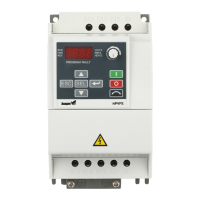66
Fault Descriptions
Table 4.A Fault Types, Descriptions and Actions
Auxiliary input interlock is open.
1.Check remote wiring.
2.Verify communications programming for
intentional fault.
Excessive DC Bus voltage ripple.
1.Monitor the incoming line for phase loss or line
imbalance.
2.Check input line fuse.
DC bus voltage fell below the
minimum value.
Monitor the incoming AC line for low voltage or line
power interruption.
DC bus voltage exceeded
maximum value.
Monitor the AC line for high line voltage or transient
conditions. Bus overvoltage can also be caused by
motor regeneration. Extend the decel time or install
dynamic brake option.
Drive is unable to accelerate
motor.
Increase P109 and/or A402 [Accel Time x] or
reduce load so drive output current does not
exceed the current set by parameter A441 [Current
Limit].
Internal electronic overload trip.
1.An excessive motor load exists. Reduce load so
drive output current does not exceed the current set
by parameter P103 [Motor OL Current].
2.Verify A453 [Boost Select] setting
Heatsink temperature exceeds a
predefined value.
1.Check for blocked or dirty heat sink fins. Verify
that ambient temperature has not exceeded 40
°
C
(104
°
F) for IP 30/NEMA 1/UL Type 1 installations
or 50°C (122°F) for IP20/Open type installations.
2.Check fan.
The drive output current has
exceeded the hardware current
limit.
Check programming. Check for excess load,
improper A453 [Boost Select] setting, DC brake
volts set too high or other causes of excess current.
A current path to earth ground has
been detected at one or more of
the drive output terminals.
Check the motor and external wiring to the drive
output terminals for a grounded condition.
(1)
See page 4-1 for a description of fault types.
(1) See page 4-1 for a description of fault types.

